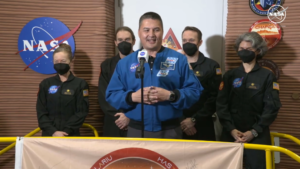Four Analog Astronauts Complete 378-Day Practice Mars Mission
Two men and two women who spent more than a year in a simulated Mars habitat emerged from isolation today. Although they actually were here on planet Earth, they lived as much as is feasible as though they were on Mars 140 million miles from family, friends and supplies. It was the first of three NASA Crew Health and Performance Exploration Analog or CHAPEA missions that the agency plans to conduct over the next several years.
NASA astronaut Kjell Lindgren greeted the foursome as they exited their 3D-printed enclosure at Johnson Space Center to see their families and friends in person for the first time in 378 days.

The CHAPEA crew was commanded by Kelly Haston, with Ross Brockwell as Flight Engineer, Nathan Jones as Medical Officer, and Anca Selariu as Science Officer. Haston has a Ph.D. in biomedical sciences from the University of California San Fransciso and Stanford. Brockwell is a structural engineer and public works administrator with a master’s in aeronautics from Caltech. Jones is an emergency medicine physician with a medical doctorate from Southern Illinois University School of Medicine. Selariu, a native of Romania, is a microbiologist in the U.S. Navy and has a doctorate in interdisciplinary biomedical sciences from Rutgers.

During their 378-day simulated Mars mission, they lived in a 1,700 square foot habitat called Mars Dune Alpha that NASA says resembles what a future crew can expect on Mars. The gravity on Mars is only one-third that of Earth, however, which cannot be simulated. Humans will have to bring whatever air, water, food and other supplies they’ll need. This exercise relied on pre-packaged, shelf-stabilized food together with some crops that could be grown similar to systems for indoor home gardening.


CHAPEA Principal Investigator Grace Douglas said the crew’s experience provided “thousands of data points yielding a unique and valuable integrated data set in a Mars-realistic simulation” that will provide insight into how to accomplish human missions to Mars in the future.
LIVE NOW: The first ever CHAPEA crew will exit the ground-based Mars simulated habitat after 378 days. https://t.co/vFESM9DUyw
— NASA’s Johnson Space Center (@NASA_Johnson) July 6, 2024
Haston said CHAPEA-1 “has been a unique experience with great challenges, joys, and sorrows, and a lot of hard work, with a fair bit of fun thrown in as well.”

A second CHAPEA mission is planned for 2025 and a third in 2027.
User Comments
SpacePolicyOnline.com has the right (but not the obligation) to monitor the comments and to remove any materials it deems inappropriate. We do not post comments that include links to other websites since we have no control over that content nor can we verify the security of such links.